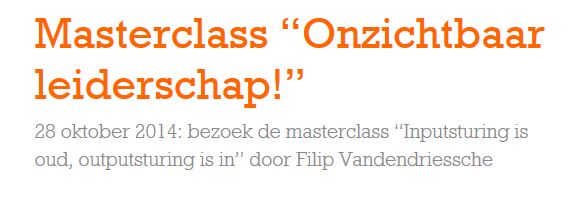ING organizes a free master class (in Dutch) on Output Steering by Filip Vandendriessche. This is a unique opportunity that you don’t want to miss out on!
Out with input-steering, in with output-steering: Dutch bank ING organizes a master class Output Management (in Dutch) on October 28th, 2014. No other than Filip Vandendriessche himself – the Belgian Output-steering guru – will explain the ins and outs of output steering and Invisible Leadership. This is an excellent opportunity for anyone who’s interested in ouput steering. I have attended one of his master classes before, and in my experience Mr. Vandendriessche is both an excellent speaker and an inspirational trainer.
As you can read in many of my posts (for example link, link, link or link), I strongly believe in Output Steering. Moreover, it is an essential part of Super7 Operations.
You can enlist on ING’s Dutch recruitment site: http://www.ing.jobs/Nederland/Over-ING/Ontmoet-ons/Kalender/Evenement/Masterclass-Onzichtbaar-leiderschap.htm

And you find more information on ING on www.ing.nl and http://www.ing.jobs/Nederland/Home.htm
Menno R. van Dijk.




